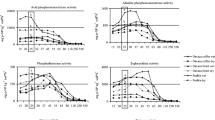Abstract
A method is described for determining biodegradation kinetics of both naturally occurring and xenobiotic compounds in surface and sub-surface soil samples. The method measures both respiration and uptake into cellular biomass of14C-labeled substrates. The estimation of biomass incorporation entailed removal of cells from soil particles by washing the soil with a polyvinyl-pyrrolidone/pyrophosphate solution and H2O2. After separation of the cells and the soil particles by centrifugation, the cells were trapped on membrane filters for liquid scintillation counting. Mass balances were easily obtained. The technique was used to measure metabolic activity in soil profiles, including unsaturated and saturated zones. First order rate constants (K1) were in the range of 10−3−10−2 hour−1 for amino acid metabolism and 10−5−10−4 hour−1 for m-cresol metabolism. Saturation kinetics were observed for amino acids and m-cresol. m-Cresol K1 values for uptake often exceeded those for respiration by greater than a factor of ten. Vmax values were low (amino acids, 101−102 ng g−1 hour−1; m-cresol, 10−1 ng g−1 hour−1), whereas Km values were quite high (amino acids, 103−104 ng g−1; m-cresol 103−105 ng g−1). Saturation was not observed in many horizons even at 105 ng g−1 dry soil. Frequently, respiration obeyed saturation kinetics whereas uptake was first order. It is concluded that measuring only kinetics of respiration may lead to severe underestimations of biodegradation rates.
Similar content being viewed by others
References
Alexander M (1981) Biodegradation of chemicals of environmental concern. Science 211:132–138
Balkwill DL, Ghiorse WC (1985) Characterization of subsurface bacteria associated with two shallow aquifers in Oklahoma. Appl Environ Microbiol 50:580–588
Bitton G, Gerba CP (1984) Groundwater pollution microbiology: the emerging issue. In: Bitton G, Gerba CP (eds) Groundwater pollution microbiology. Wiley, New York, pp 1–7
Dobbins DC, Thornton-Manning JR, Jones DD, Federle TW (1987) Mineralization potential for phenol in subsurface soils. J Environ Qual 16:54–58
Federle TW, Dobbins DC, Thornton JR, Jones DD (1986) Microbial biomass, activity, and community structure in subsurface soils. Ground Water 24:365–374
Ferroni GD, Leduc LG, Winterhalder EK (1985) The measurement of mineralization activity in soils. Soil Biol Biochem 17:727–728
Ghiorse WC, Balkwill DL (1983) Enumeration and morphological characterization of bacteria indigenous to subsurface environments. Dev Indust Microbiol 24:213–224
Hamilton RD, Austin KE (1967) Assay of relative heterotrophic potential in the sea: the use of specifically labeled glucose. Can J Microbiol 13:1165–1173
Harrison MJ, Wright RT, Monta RY (1971) Method for measuring mineralization in lake sediments. Appl Microbiol 21:698–702
Li WKW (1983) Consideration of errors in estimating kinetic parameters based on Michaelis-Menten formalism in microbial ecology. Limnol Oceanogr 28:185–190
McCarty PL, Reinhard M, Rittman BE (1981) Trace organics in groundwater. Environ Sci Tcchnol 15:40–48
Page GW (1981) Comparison of groundwater and surface water for patterns and levels of contamination by toxic substances. Environ Sci Technol 15:1475–1481
Pfaender FK, Bartholomew GW (1982) Measurement of aquatic degradation rates by determining heterotrophic uptake of radiolabeled pollutants. Appl Environ Microbiol 44:159–164
Pye VI, Patrick R (1983) Groundwater contamination in the United States. Science 221:713–718
Ventullo RM, Larson RJ (1985) Metabolic diversity and activity of heterotrophic bacteria in ground water. Environ Toxicol Chem 4:759–771
White DC, Smith GA, Gehron MJ, Parker JH, Findlay RH, Martz RF, Fredrickson HL (1983) The groundwater aquifer microbiota: biomass, community structure, and nutritional status. Dev Ind Microbiol 24:201–211
Wilson JT, Miller GD, Ghiorse WC, Leach FR (1986) Relationship between the ATP content of subsurface material and the rate of biodegradation of alkyl benzenes and chlorobenzene. J Contam Hydrol 1:163–170
Wilson JT, McNabb JF (1983) Biological transformation of organic pollutants in groundwater. EOS 64:505–507
Wilson JT, McNabb JF, Balkwill DL, Ghiorse WC (1983) Enumeration and characterization of bacteria indigenous to a shallow watertable aquifer. Ground Water 21:134–142
Wilson JT, McNabb JF, Wilson BH, Noanan MJ (1983) Biotransformation of selected organic pollutants in groundwater. Dev Ind Microbiol 24:225–233
Wright RT, Hobbie JE (1965) The uptake of organic solutes in lake water. Limnol Oceanogr 9:163–178
Author information
Authors and Affiliations
Rights and permissions
About this article
Cite this article
Dobbins, D.C., Pfaender, F.K. Methodology for assessing respiration and cellular incorporation of radiolabeled substrates by soil microbial communities. Microb Ecol 15, 257–273 (1988). https://doi.org/10.1007/BF02012641
Issue Date:
DOI: https://doi.org/10.1007/BF02012641



